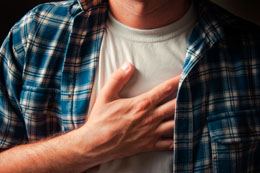Inflammation occurs in chest if there is some swelling in the bones and cartilage present in the chest wall. Go through this article to get more information on its causes, symptoms and treatment.

The medical term used for describing chest wall inflammation is costochondritis or Tietze's Syndrome. In this condition, the cartilage that joins a rib to the breastbone or the sternum gets inflamed. As a result, a sharp, intense pain is felt in the costosternal joint, the junction where the ribs and breastbone are connected with elastic cartilage. The swelling may occur in one or more than one ribs. It has been found that it mostly affects the second and third ribs of the rib cage.
Causes
Inflammation is mostly triggered due to an injury caused by overuse. Young athletes like rowers are more prone to this kind of injury. Such activity causes minor damage to the cartilage repeatedly and it swells up. A traumatic injury where the rib cage has been directly hit can also lead to inflammation. It may result from viral infections in the respiratory organs. Those who have undergone surgery may get bacterial infection at the surgical site as the blood flow to the area decreases after the invasive procedure. This condition increases the risk of inflammation.
Symptoms
The symptoms have a lot of similarity with the symptoms of heart attack or any other coronary heart disease. Its key symptoms are piercing chest pain along with sore and tender ribs. The pain is not confined to any one side of the chest and can be felt on either sides. Initially, the pain is experienced at the frontal part, but later on, may get extended to the neck and shoulders as well. The burning pain of the ribs can become so severe that you find it difficult to carry out the normal activities and may even disrupt your night's sleep as well. It tends to get aggravated when you lie down or bend. In worst cases, one feels stabbing pain while coughing, sneezing and taking deep breaths. Usually, the pain goes down to some extent with rest, restriction in movements and slow breathing. Apart from the painful symptoms, irregular heartbeat and breathing difficulty also show up.
Treatment
Doctors conduct physical examination and study the medical history and physical activities of the patient for the diagnosis of this condition. Some laboratory tests are then carried out to confirm that the pain is not caused by any other reason like heart disease. This kind of inflammation usually subsides on its own after a week or two. However, some medicines are required to ease off the pain and discomfort associated with it. Generally, nonsteroidal anti-inflammatory drugs and muscle relaxants are administered for pain management. In case, the pain is unbearable and is not relieved by medications, then steroid injections are administered. When there is a bacterial infection, antibiotics are given either orally or in the form of injections. If the patient finds it difficult to sleep at night because of the pain then tricyclic antidepressants are given in order to get some sleep. At home, you can apply heat with the help of heating pads on the painful site a number of times to relieve the pain temporarily.
During the course of treatment, make sure you suspend all such activities that tend to make the pain worse. You can see some improvement in the condition within the first six weeks. However, do not rush back to normal activities after that as it can trigger the inflammation all over again. You have to stay away from strenuous physical activities for the next six months in order to prevent its recurrence.


 The medical term used for describing chest wall inflammation is costochondritis or Tietze's Syndrome. In this condition, the cartilage that joins a rib to the breastbone or the sternum gets inflamed. As a result, a sharp, intense pain is felt in the costosternal joint, the junction where the ribs and breastbone are connected with elastic cartilage. The swelling may occur in one or more than one ribs. It has been found that it mostly affects the second and third ribs of the rib cage.
The medical term used for describing chest wall inflammation is costochondritis or Tietze's Syndrome. In this condition, the cartilage that joins a rib to the breastbone or the sternum gets inflamed. As a result, a sharp, intense pain is felt in the costosternal joint, the junction where the ribs and breastbone are connected with elastic cartilage. The swelling may occur in one or more than one ribs. It has been found that it mostly affects the second and third ribs of the rib cage.